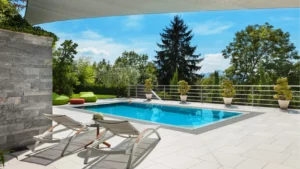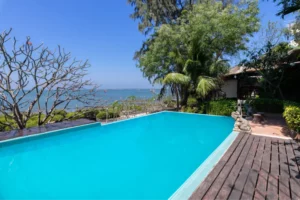A concrete pool will be a part of your family for decades to come, and it may even help improve the market value of your house.
Homeowners contemplating pool construction, particularly those considering pool finance, often want to know whether it improves the value of their home. Here are a few things to think about while weighing the swimming pool as an investment or otherwise evaluating it as an asset.
When you deal with an expert swimming concrete pool contractor like Blue Pools & Spas, you can be certain that you will have a pool project that you and your family will enjoy year after year. Here is a list of reasons why you should invest in a concrete pool.
What Exactly is a Concrete Pool?
Cement is a component of concrete, not the same substance, despite the fact that we often use the terms interchangeably. Concrete is a composite material composed of water, cement, sand, and a coarse aggregate (stone or gravel).
Spraying gunite or shotcrete creates a concrete pool shell. Shotcrete is already wet, while gunite is a dry mix with water in the sprayer. If done properly, these two techniques provide the same output and have no discernible difference in quality.
It takes time for the concrete to achieve its full capacity once it has been sprayed on. Concrete does not dry in the traditional sense. It hardens and strengthens over time, in a process known as curing. This takes approximately 28 days for a pool shell.
The strength of concrete is measured in psi, which is the number of pounds per square inch required to crush it. Concrete has an average strength of 3500-4000 psi. It is determined by the number of sacks of cement added to the mix—the more cement added, the stronger the concrete. The aggregate (the rocks or gravel put in) has a very high compressive strength: crushing concrete requires a lot of pressure.
However, since concrete has a very low tensile strength (against a force that pushes it apart), bending or flexing it causes the force to pull on the surface and fracture it. This may create surface or structural fractures in concrete pools. It’s not ideal. Pool builders mitigate this by encasing the concrete in a steel web. Steel and concrete combine to form a strong structure that can bend and flex in order to resist the effects of water, earth, and gravity.
=> You might need: How long does it take to build a concrete pool?
What are the Advantages and Disadvantages of having a Concrete Pool?
The benefits and disadvantages come down to this: concrete pools offer considerable aesthetic advantages. Maintaining that look, on the other hand, requires a significant investment of time, money, and personal effort.
Advantages of a Concrete Pool
Customizable
Concrete’s main benefit is that it is extremely customizable. Concrete pools allow you to personalize the size, form, and any other characteristics you want. If you wish, it could be in the form of a vehicle; this would be very costly but possibly feasible.
Durable
Concrete pools, like fiberglass pools, are very durable. You don’t have to worry about sharp items damaging the pool structure, which is a flaw of vinyl liners. If you wish to swim with your dogs in the pool, their claws will not damage the concrete.
Aside from that, the plaster of the pool (the interior finish) is not as durable as the concrete structure itself and must be refinished, which increases the overall cost to construct a concrete pool.
Aesthetically pleasing
Concrete is also appealing. Although “beautiful” isn’t the first word that springs to mind, concrete offers a traditional pool look. You won’t have to worry about the liner bubbling or separating, and if you keep up with concrete pool care, you’ll be able to escape the worst of the discoloration and algae.
=> Maybe you need: How much to build a concrete pool in Australia?
Disadvantages of a Concrete Pool
The lengthy setup procedure
The installation of a concrete pool is a time-consuming and labor-intensive procedure. Remember that the curing process alone takes almost a month, and there is a lot more to the building process than that. Concrete pools take 3-6 months to build, as opposed to fiberglass and vinyl liner pools, which may be finished in a matter of weeks.
Rough terrain
A concrete pool’s inside is tough, but it’s also abrasive and may scratch your skin, particularly in children. Even if you refinish the plaster on a regular basis, there isn’t much you can do about the texture.
A lot of upkeep
Concrete pools have a greater lifetime cost (follow-up expenses and maintenance) than vinyl liners or fiberglass pools.
Concrete pools require a significant amount of hands-on upkeep. Because of the permeable structure of concrete, algae thrives in it. Algae is very difficult to remove after it has been entrenched in the surface of a concrete pool. Concrete pool designers really suggest cleaning the whole surface of the pool with a steel brush at least once a week to eliminate any algae that has accumulated on the surface.
Because the majority of this regular maintenance does not require expert assistance, you will be responsible for this upkeep. Hiring a professional pool service, on the other hand, will save you time but not money.
Significant time and money are invested
Another problem with concrete pools is water chemistry. Because algae embeds in the surface, more chemicals are required to reach and kill it. Furthermore, since concrete is alkaline, it continuously raises the pH of the pool water. To maintain the water balance, you must test it and add acid to it on a regular basis.
This necessitates extra time and money to keep the pool in good condition.
Refinishing on a regular basis
Because concrete is incompatible with salt, dissolved salt in pool water will reduce the life expectancy of a concrete pool’s interior finish. As a result, you will need to refinish the plaster every 10-15 years, and you will need to employ experts to do it.
Concrete pools are considerably more expensive to own in the long run than fiberglass or vinyl-liner pools. Follow-up maintenance and expenditures such as acid cleaning by experts every 3-5 years, more money spent on chemicals, more money spent on power, and refinishing/remodeling compound the original cost.
What other alternatives do I have?
Knowing the components, pricing, pros and drawbacks, and building procedure of a concrete pool can help you get started on the correct track for your situation—but this isn’t all you need to know to make an informed choice.
You can evaluate the pros and disadvantages of fiberglass, vinyl liners, and concrete pools here to ensure you’re getting the greatest value and fit for your house. For example, you’ll see that fiberglass pools avoid the drawbacks of concrete pools while achieving the majority of their benefits.
Blue Pools & Spas designs and installs world-class swimming pools for clients across Melbourne. Check out our gallery to see what we can accomplish for your inground pool project. We offer swimming pools in a variety of shapes and sizes, as well as pools for small to big backyards. Contact us now to discuss the details of your project and get a free quote.










